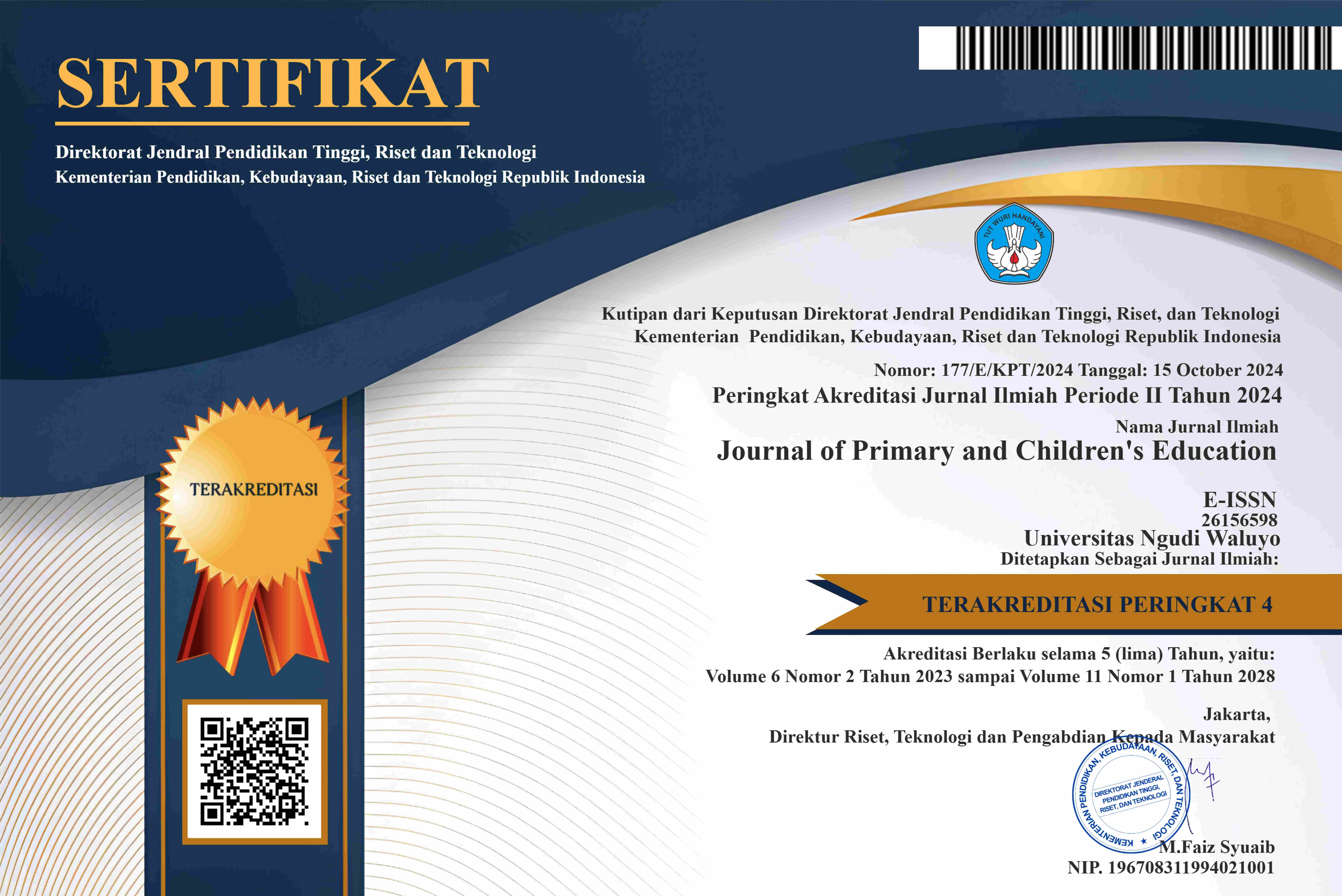KEFEKTIFITASAN MODEL PEMBELAJARAN TWO STAY TWO STRAY TERHADAP KEMAMPUAN BERBICARA SISWA KELAS IV SD NEGERI MANGUNHARJO SEMARANG
DOI:
https://doi.org/10.35473/jnctt.v3i2.396Abstract
The background of this research is the still centered learning of the teacher and the lack of courage of students to express an opinion, this is also supported by the incompleteness of Indonesian language learning, precisely in the speaking ability of fourth grade students of SD Negeri Mangunharjo Semarang. This study aims to determine whether the two stay two stray learning model is effective on the speaking ability of fourth grade students of SD Negeri Mangunharjo Semarang. This type of research is quantitative research using Pretest-Posttest one-Group Design. After taking the data, then analyzing the data of the pretest and posttest learning outcomes with the t-test that was obtained with an average pretest value of 57.12 and an average posttest value of 80.19. With N = 26, obtained tcount = 17.29282 with a 5% significance level of 2.055529. Because tcount = 17.29282> table = 2.055529. Then this shows that the t test has a significant effect. This shows that there is an effect of learning the Two Stay Two Stray (TSTS) model. Suggestions that can be delivered by researchers to teachers is that learning is not only centered on the teacher, but also involves the activeness of students in order to achieve enjoyable learning and students have an interest in learning.
References
Aini, Annisa. 2012. Metode Mind Mapping Untuk Meningkatkan Keterampilan Berbicara Siswa Sekolah Dasar. Jurnal Penelitian Bahasa, Sastra Indonesia dan Pengajarannya, Volume 1, Nomor 1.
Laman : https://jurnal.fkip.uns.ac.id/index.php/bhs_indonesia/article/view/2072
Al-Tabany, Trianto Ibnu Badar. 2015. Mendesain Model pembelajaran inovatif , progresif , dan kontekstual. Jakarta : Kencana.
Arifin, Zainal. 2016. Evaluasi Pembelajaran. Bandung : PT. Remaja Rosdakarya Offset.
Cahyani, Novianti Ayu. 2017. Penerapan Metode VAKS (Visual, Auditory, Kinestethic, Sugestopedia) Pada Materi Memerankan Tokoh Drama. Jurnal Pena Ilmiah Vol.2 No.1.
Laman : https://ejournal.upi.edu/index.php/penailmiah/article/view/10470
Fathurohman, Muhammad. 2017. Model model pembelajaran inovatif. Yogyakarta : Ar-Ruzz Media.
Hilaiyah, Tatu. 2017. Tes Keterampilan Berbicara Siswa dalam Pembelajaran. Jurnal Membaca Bahasa & Sastra Indonesia. Volume 2 Nomor 1 April 2017.
Laman http://jurnal.untirta.ac.id/index.php/jurnalmembaca/article/view/1559/0
Huda, Miftahul. 2014. Model model pengajaran dan pembelajaran. Yogyakarta : Pustaka Belajar.
Ismawati, Esti dan Faraz Umaya. 2016. Belajar bahasa di kelas awal. Yogyakarta : Penerbit Ombak.
Rosdiana, Yussi dkk. 2009. Bahasa dan sastra Indonesia di SD. Jakarta : Universitas Terbuka.
Saputri, R. W., Nur Amalia, S. S., & Teach, M. (2018). Analisis Keterampilan Berbicara Siswa Kelas Tinggi Pada Pembelajaran Bahasa Indonesia Di SD Negeri 2 Selo (Doctoral dissertation, Universitas Muhammadiyah Surakarta).
Shoimin, Aris. 2014. 68 Model pembelajaran inovatif dalam kurikulum 2013. Yogyakarta : Ar-Ruzz Media.
Soegeng, AY. 2016. Dasar Dasar Penelitian. Yogyakarta : Magnum Pustaka Utama.
Suarsih, Cicih. 2018. Upaya Meningkatkan Keterampilan Berbicara Siswa Dengan Menerapkan Metode Show And Tell Pada Pembelajaran Bahasa Dan Sastra Indonesia. Jurnal Penelitian Guru FKIP Universitas Subang, Volume 1 No. 1.
Laman : http://ejournal.unsub.ac.id/index.php/JPG/article/view/235
Subyantoro. 2013. Teori Pembelajaran bahasa. Semarang : Unnes Press.
Sugiyono. 2009. Metode Penelitian Kuantitatif, Kualitatif, dan R&D. Bandung: Alfabeta
Published
How to Cite
Issue
Section
License
Copyright notice:
- Authors retain copyright and grant the journal right of first publication with the work simultaneously licensed under Creative Commons Attribution License that allows others to share the work with an acknowledgement of the work's authorship and initial publication in this journal.
- Authors are able to enter into separate, additional contractual arrangements for the non-exclusive distribution of the journal's published version of the work (e.g., post it to an institutional repository or publish it in a book), with an acknowledgement of its initial publication in this journal.
- Authors are permitted and encouraged to post their work online (e.g., in institutional repositories or on their website) prior to and during the submission process, as it can lead to productive exchanges, as well as earlier and greater citation of published work (The Effect of Open Access)







